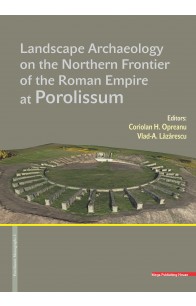Rezultate căutare pentru 'Adrian Ursu��iu'
„Ce second supplément des Inscriptiones Daciae Romanae représente, tout comme le premier, une préparation à la publication des fascicules du quatrième volume des IDR, contenant les inscriptions de Dacie Porolissensis. Il comprend la grande majorité des estampilles sur briques et tuiles du Musée National d’Histoire de Transylvanie de Cluj-Napoca. Malheureusement, pour des raisons techniques, nous n’avons pas eu accès aux pièces prêtées en 1971 au Musée National d’Histoire de Roumanie de Bucarest, lors de la constitution de celui-ci1. Au fil de plusieurs années Mme Viorica Rusu Bolindeț avait apporté dans le dépôt du musée des dizaines de tuiles estampillées du prétoire du consulaire d’Apulum, mais on n’a pas pu agréer aucune solution afin de citer son manuscrit. Du point de vue scientifique la perte n’est pas grande, car il s’agit de types bien connus, publiés dans IDR III/6. En revanche, nous remercions chaleureusement Mme Adriana Isac pour nous avoir permis d’utiliser toutes les pièces provenant du camp de Gilău, dont certaines inédites. Au début de 1997 des tuiles estampillées représentatives ont été envoyées au musée de Zalău en vue d’une exposition illustrant la vie militaire dans le nord de Dacie. Elles n’ont plus été restituées. Afin d’éviter des problèmes administratifs, on les a inclues dans le premier supplément, qui contient les inscriptions sur les briques et les tuiles du musée de Zalău. Le présent volume ne représente pas moins un catalogue du musée de Cluj.” (Prooemium)
„În urmă cu mai bine de 30 de ani, în timpul uceniciei pe șantierele arheologice ale profesorului Gheorghe Lazarovici, ne-am întâlnit pentru prima dată cu studiile interdisciplinare între arheologie și etnografie, religie etc. La vremea respectivă am considerat aceste inițiative drept un pionierat fără o finalitate în cercetarea fundamentală. La cercetările organizate de profesorul Gheorghe Lazarovici am avut onoarea să-l cunosc pe John Nandriș, care ne-a descchis drumul către această cercetare interdisciplinară. Remarc în mod deosebit aportul de nepreţuit al prof. univ. dr. John Nandriş care pe lângă faptul că a făcut posibilă implementarea unui proiect cu tematică etnoarheologică în România acelor ani a atras atenţia întregii lumi ştiinţifice asupra zonei de sud-est a Europei, mai ales a zonei muntoase înalte a munţilor din România, zone prea puţin explorate. Muzeul pe care astăzi îl conduc are bucuria de a prezenta specialiștilor, și nu numai, o serie de studii aprofundate ale acestui domeniu. Instituția noastră, pe lângă preocupările arheologice, acordă o atenție deosebită cercetărilor etnografice din spațiul Banatului de Munte. (..)
Volumul de față reunește studii deosebit de importante din ultimii 30 de ani, care deschid o nouă perspectivă asupra interdisciplinarității arheologice. Prezenta lucrare este o sinteză a unei munci asidue din partea unor cercetători de renume, care valorifică bogatul patrimoniu arheologic şi etnografic al spaţiului românesc. ” - dr. Adrian Ardeț
„The frontiers of the Roman Empire, over 5000 km long, stretch from the Atlantic coast of Scotland, along the Rhine and the Danube, also enclose the Banat region and Transylvania, then going down along the Oriental Carpathians to the Black Sea; from the southern coast of the Black Sea they continue towards the Near East until the Red Sea; then, in North Africa, they line the edge of the Sahara desert until the Atlantic coast of Morocco. Over this entire area, visible traces of fortifications, roads and settlements are still preserved, but numerous monuments still lay hidden underneath the earth. Despite the fact that the Roman frontiers crossed regions with different relief and climate, they constitute a whole in that they were designed to protect Roman territories. The research of these monuments and the preservation policy regarding them was and is unequal in the various presentday states on whose territory traces of the Roman frontier are to be found. Consequently, in the ‘80s of the 20th century, the idea of globally protecting the Roman frontiers, viewed as a unitary monument, was met. In 1987, Hadrian’s Wall in United Kingdom was declared a UNESCO monument. It was followed in 2005 by the German-Raetian sector, on which occasion the UNESCO committee decided to set up the ‘Frontiers of the Roman Empire’ site. (...)
This project through its complexity generated an interdisciplinary approach of the proposed subject stimulating such future attempts in the archaeological research field. By using the latest technical methods of non-destructive investigation the project did not damage the stratigraphy of the archaeological site obtaining instead a high amount of data otherwise time consuming judging from the archaeological excavations perspective contributing also to the preservation of the cultural heritage.” - Introduction
Țara Năsăudului este una dintre micro-regiunile României care s-a bucurat de o atenţie ştiinţifică aparte, nu doar din partea istoricilor, ci dinspre întregul spectru al ştiinţelor umaniste şi sociale. Bibliografiile istorice ale României au acumulat, volum de volum, numeroase titluri dedicate temei: fie cărţi, fie studii şi articole provenite atât din periodice ştiinţifice locale, cât şi din principalele reviste de istorie din centrele universitare sau din diverse volume de studii. Această valoroasă literatură ştiinţifică a devenit în timp tot mai amplă, solicitând cercetătorilor, şi mai ales cercetătorilor debutanţi, un efort consistent de documentare bibliografică.
Organizarea şi activitatea Regimentului 17 (2 românesc) de graniţă pe teritoriul năsăudean au legat acest spaţiu de ansamblul istoriei Monarhiei habsburgice într-un mod mai intim şi pe alocuri chiar mai spectaculos decât alte regiuni locuite de români. (din „Introducere”)







